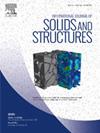A novel high-precision non-classical method to solve fractional rheology and viscoelastic vibration: Linear computational complexity and experimental verification
IF 3.4
3区 工程技术
Q1 MECHANICS
International Journal of Solids and Structures
Pub Date : 2025-03-16
DOI:10.1016/j.ijsolstr.2025.113341
引用次数: 0
Abstract
The theory of fractional calculus can precisely depict the non-integer order characteristics of materials, especially when it comes to predicting viscoelastic behaviors such as rheology and viscoelastic damping. Despite the marked superiority of fractional calculus in the realm of viscoelastic material modeling, its numerical processing encounters numerous challenges. This is because traditional computational methods for handling such problems must deal with a large amount of historical data, thus leading to low efficiency. Moreover, existing non-classical methods typically find it arduous to simultaneously take into account both computational accuracy and efficiency. In light of the aforementioned issues, this study presents an innovative non-classical computational approach. Through the implementation of the piecewise processing strategy, this study effectively addresses the inherent limitation of weak algebraic decay in the infinite state representation associated with non-classical methods. This innovative approach not only achieves a substantial improvement in computational accuracy but also maintains an efficient linear computational complexity, thereby striking an optimal balance between precision and computational efficiency. This method has been successfully applied to the solution of multi-component fractional viscoelastic constitutive equations and verified through experiments. Furthermore, based on the nonlocal strain gradient theory and the fractional-order constitutive relation, the nonlinear motion equation of the fractional viscoelastic nanobeam is derived. Comparative analyses of the vibration responses of the linear and nonlinear models are conducted, revealing the nonlinear viscoelastic damping characteristics of the system. The research outcomes indicate that this method is applicable to addressing fractional viscoelastic mechanics problems and holds the potential to extend to a broader category of fractional differential equations, being capable of providing computational support for multiple disciplines.

解决分数流变学和粘弹性振动的新型高精度非经典方法:线性计算复杂性与实验验证
分数阶微积分理论可以精确地描述材料的非整数阶特性,特别是在预测材料流变和粘弹性阻尼等粘弹性行为时。尽管分数阶微积分在粘弹性材料建模领域具有明显的优势,但它的数值处理遇到了许多挑战。这是因为处理此类问题的传统计算方法必须处理大量的历史数据,从而导致效率低下。此外,现有的非经典方法往往难以同时兼顾计算精度和效率。针对上述问题,本研究提出了一种创新的非经典计算方法。通过分段处理策略的实现,本研究有效地解决了与非经典方法相关的无限状态表示中弱代数衰减的固有局限性。这种创新的方法不仅实现了计算精度的大幅提高,而且保持了高效的线性计算复杂度,从而在精度和计算效率之间取得了最佳平衡。该方法已成功地应用于多组分分数阶粘弹性本构方程的求解,并通过实验得到了验证。基于非局部应变梯度理论和分数阶本构关系,推导了分数阶粘弹性纳米梁的非线性运动方程。对线性模型和非线性模型的振动响应进行了对比分析,揭示了系统的非线性粘弹性阻尼特性。研究结果表明,该方法适用于求解分数阶粘弹性力学问题,并有可能扩展到更广泛的分数阶微分方程,能够为多学科提供计算支持。
本文章由计算机程序翻译,如有差异,请以英文原文为准。
求助全文
约1分钟内获得全文
求助全文
来源期刊
CiteScore
6.70
自引率
8.30%
发文量
405
审稿时长
70 days
期刊介绍:
The International Journal of Solids and Structures has as its objective the publication and dissemination of original research in Mechanics of Solids and Structures as a field of Applied Science and Engineering. It fosters thus the exchange of ideas among workers in different parts of the world and also among workers who emphasize different aspects of the foundations and applications of the field.
Standing as it does at the cross-roads of Materials Science, Life Sciences, Mathematics, Physics and Engineering Design, the Mechanics of Solids and Structures is experiencing considerable growth as a result of recent technological advances. The Journal, by providing an international medium of communication, is encouraging this growth and is encompassing all aspects of the field from the more classical problems of structural analysis to mechanics of solids continually interacting with other media and including fracture, flow, wave propagation, heat transfer, thermal effects in solids, optimum design methods, model analysis, structural topology and numerical techniques. Interest extends to both inorganic and organic solids and structures.

 求助内容:
求助内容: 应助结果提醒方式:
应助结果提醒方式:


